The Changing Angle of Saturns Rings
- Overview
- Detail
- History
- Origin
Annual images of Saturn & its Ring System which show the changing angle as seen from Earth.
(Click on the Year to see all images from that period)
The rings of Saturn are the most extensive ring system of any planet in the Solar System. They consist of countless small particles, ranging in size from micrometers to meters, that orbit around Saturn. The ring particles are made almost entirely of water ice, with a trace component of rocky material. There is still no consensus as to their mechanism of formation. Although theoretical models indicated that the rings were likely to have formed early in the Solar System’s history, new data from Cassini suggest they formed relatively late.
Saturn’s axial tilt is 26.7°, meaning that widely varying views of the rings are obtained from Earth at different times, raging from wide-open to edge-on. Earth makes passes through the ring plane every 13 to 15 years, about every half Saturn year, and there are about equal chances of either a single or three crossings occurring in each such occasion. The most recent ring plane crossings were on 22 May 1995, 10 August 1995, 11 February 1996 and 4 September 2009; upcoming events will occur on 23 March 2025, 15 October 2038, 1 April 2039 and 9 July 2039. Favorable ring plane crossing viewing opportunities (with Saturn not close to the Sun) only come during triple crossings.
Saturn’s equinoxes, when the Sun passes through the ring plane, are not evenly spaced; on each orbit the sun is south of the ring plane for 13.7 Earth years, then north of the plane for 15.7 years. Dates for its northern hemisphere autumnal equinoxes include 19 November 1995 and 6 May 2025, with northern vernal equinoxes on 11 August 2009 and 23 January 2039. During the period around an equinox the illumination of most of the rings is greatly reduced, making possible unique observations highlighting features that depart from the ring plane. (wiki)
Although reflection from the rings increases Saturn’s brightness, they are not visible from Earth with unaided vision. In 1610, the year after Galileo Galilei turned a telescope to the sky, he became the first person to observe Saturn’s rings, though he could not see them well enough to discern their true nature. In 1655, Christiaan Huygens was the first person to describe them as a disk surrounding Saturn. The concept that Saturn’s rings are made up of a series of tiny ringlets can be traced to Pierre-Simon Laplace, although true gaps are few – it is more correct to think of the rings as an annular disk with concentric local maxima and minima in density and brightness. On the scale of the clumps within the rings there is much empty space. (wiki)
Estimates of the age of Saturn’s rings vary widely, depending on the approach used. They have been considered to possibly be very old, dating to the formation of Saturn itself. However, data from Cassini suggest they are much younger, having most likely formed within the last 100 million years, and may thus be between 10 million and 100 million years old.
There are two main theories regarding the origin of Saturn’s inner rings. One theory, originally proposed by Édouard Roche in the 19th century, is that the rings were once a moon of Saturn (named Veritas, after a Roman goddess who hid in a well) whose orbit decayed until it came close enough to be ripped apart by tidal forces. A variation on this theory is that this moon disintegrated after being struck by a large comet or asteroid. The second theory is that the rings were never part of a moon, but are instead left over from the original nebular material from which Saturn formed. (wiki)
August 03
Irvine CA.
- Celestron C11 @ f20
- BARADV – 5600mm
- Astro Physics 1100GTO
- ZWO ASI178MM/CFW
- Chroma RGB Filters





